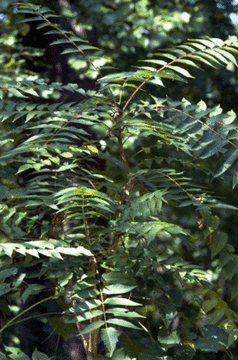Natonal Park Mystery Plant 4 (see yesterday's Traveler) is the tree-of-heaven (Ailanthus altissima), also commonly called the Ailanthus, Chinese sumac, or stinking sumac. In certain areas it is called paradise tree, although that name properly belongs to Simarouba glauca, a tree of the tropics and subtropics. In urban areas, where it grows in vacant lots and in unlikely places like alleys, gutters, parking lots, and aging trash heaps, it is sometimes called "ghetto palm" or "stink tree." (The Chinese view the tree more favorably, since bark extracts are used in traditional Chinese medicine.)
Tree-of-heaven is certainly an unlikely name for a tree that is so often thought of as “the tree from hell.” Farmers, ranchers, park managers, city maintenance staff, utility workers, and many others despise the tree-of-heaven because it is an aggressive, difficult-to-get-rid-of invader that vigorously grows where it ought not to, inflicting costly damage to cropland, degrading natural ecosystems, damaging pavement and building foundations, and causing a stink in both the metaphorical and literal sense. Gardeners and landscapers don’t like it either because of its weedy growth and stinking flowers. Small wonder that the tree-of-heaven is considered a noxious weed in the United States, not to mention Australia, New Zealand, and several southern and eastern European countries.
Eradicating the tree-of-heaven in colonized areas is difficult and expensive, especially once it is well established in clonal thickets. There are no effective biological controls for this tree, which is native to northern and central China, northern Korea, and Taiwan, but has been in this country only since 1784. The manual/mechanical controls that work well for some invasive plant species are problematic for the tree-of-heaven. You can’t just cut the trees down and forget them, because stumps promptly sprout vigorous new growth. Repeated cutting of the sprouts will eventually exhaust the trees’ metabolic reserve, but getting rid of a large infestation that way is time consuming, costly, and often deemed impractical. Chemical control – spraying with appropriate pesticides -- is faster and cheaper than manual/mechanical removal, but must be used with due caution.
The Plant Conservation Alliance’s Working Group has this to say about controlling the tree-of-heaven, which is on its “Least Wanted” list:
Elimination of [the tree-of-heaven] requires diligence, due to its abundant seed production, high seed germination rate, and vegetative reproduction. Followup monitoring and treatment when needed should be an integral part of any serious ailanthus management program. Regardless of method selected, treated areas should be rechecked one or more times a year and any new suckers or seedlings treated (cut, sprayed or pulled) as soon as possible, especially before they are able to rebuild root reserves. Establishing a thick cover of trees (non-invasive and preferably native) or grass sod will help shade out and discourage establishment of ailanthus seedlings. Targeting large female trees for control will help reduce spread of ailanthus by seed.
Postscript: Author Betty Smith’s famous 1943 book A Tree Grows in Brooklyn uses the tree-of-heaven as its central metaphor, the main idea being that it can thrive in hostile environment, including blighted urban areas. She wrote:
There's a tree that grows in Brooklyn. Some people call it the Tree of Heaven. No matter where its seed falls, it makes a tree which struggles to reach the sky. It grows in boarded up lots and out of neglected rubbish heaps. It grows up out of cellar gratings. It is the only tree that grows out of cement. It grows lushly....[surviving] without sun, water, and seemingly earth. It would be considered beautiful except that there are too many of it.




Add comment